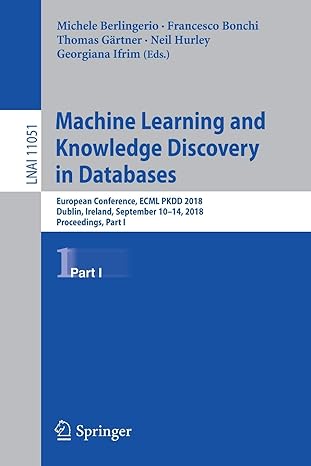Question
#include #include #include #include #include #include #include #include #include // A struct to represent a rating given by a user to an item struct Rating
#include
#include
#include
#include
#include
#include
#include
#include
#include
// A struct to represent a rating given by a user to an item
struct Rating {
int user_id;
int item_id;
float rating;
};
// A struct to represent a predicted rating for an item
struct PredictedRating {
int id;
int user_id;
int item_id;
float rating;
};
// Reads the ratings from a .csv file and returns them as a vector
std::vector
std::vector
std::ifstream file(filename);
if (file.is_open()) {
std::string line;
// Skip the first line (header)
std::getline(file, line);
while (std::getline(file, line)) {
Rating rating;
std::sscanf(line.c_str(), "%d,%d,%f", &rating.user_id, &rating.item_id, &rating.rating);
ratings.push_back(rating);
}
file.close();
}
return ratings;
}
// Reads the test cases from a .csv file and returns them as a vector
std::vector
std::vector
std::ifstream file(filename);
if (file.is_open()) {
std::string line;
// Skip the first line (header)
std::getline(file, line);
while (std::getline(file, line)) {
PredictedRating test_case;
std::sscanf(line.c_str(), "%d,%d,%d", &test_case.id, &test_case.user_id, &test_case.item_id);
test_cases.push_back(test_case);
}
file.close();
}
return test_cases;
}
// Calculates the root mean squared error between the predicted ratings and the actual ratings
float calculate_rmse(const std::vector
float sum_squared_error = 0.0f;
for (const auto& predicted_rating : predicted_ratings) {
auto actual_rating_iter = std::find_if(actual_ratings.begin(), actual_ratings.end(), [&](const Rating& r) {
return r.user_id == predicted_rating.user_id && r.item_id == predicted_rating.item_id;
});
if (actual_rating_iter != actual_ratings.end()) {
sum_squared_error += std::pow(predicted_rating.rating - actual_rating_iter->rating, 2);
}
}
return std::sqrt(sum_squared_error / predicted_ratings.size());
}
float predict_rating_mean_item(int user_id, int item_id, const std::unordered_map
// If the item has not been rated by any users, return the mean rating of all items
if (item_ratings.count(item_id) == 0) {
float sum_ratings = 0.0f;
int num_ratings = 0;
for (const auto& [_, ratings] : item_ratings) {
for (const auto& rating : ratings) {
sum_ratings += rating.rating;
num_ratings++;
}
}
return sum_ratings / num_ratings;
}
else {
// If the item has been rated by at least one user, return the mean rating of the item
float sum_ratings = 0.0f;
int num_ratings = 0;
for (const auto& rating : item_ratings.at(item_id)) {
sum_ratings += rating.rating;
num_ratings++;
}
return sum_ratings / num_ratings;
}
}
int main() {
// Read in the training and test sets
std::vector
std::vector
// Initialize a map to store the ratings received by each item
std::unordered_map
for (const auto& rating : training_set) {
item_ratings[rating.item_id].push_back(rating);
}
std::fstream fout;
// opens an existing csv file or creates a new file.
fout.open("report.csv", std::ios::out | std::ios::app);
// Predict the ratings for the test set using the mean rating of the item
for (auto& predicted_rating : test_set) {
predicted_rating.rating = predict_rating_mean_item(predicted_rating.user_id, predicted_rating.item_id, item_ratings);
fout << std::to_string(predicted_rating.id) << ","
<< std::to_string(predicted_rating.rating) << " ";
}
// Calculate the RMSE between the predicted ratings and the actual ratings
float rmse = calculate_rmse(test_set, training_set);
std::cout << "RMSE: " << rmse << std::endl;
return 0;
}
"Explanation:
In this code, the read_ratings function reads in ratings from a .csv file and returns them as a vector of Rating structs. The read_test_cases function reads in test cases from a .csv file and returns them as a vector of PredictedRating structs. The predict_rating_matrix_factorization function takes as input the user and item IDs of a user-item pair, and the matrices U and V that contain the latent factors for the users and items, respectively. It returns the predicted rating for the user-item pair as the dot product of the corresponding rows in the matrices U and V. The calculate_rmse function calculates the root mean squared error between the predicted ratings and the actual ratings. It does this by iterating over the predicted ratings and finding the corresponding actual rating for each user-item pair. If an actual rating is found, it calculates the squared error between the predicted and actual ratings and adds it to a running sum. The RMSE is then calculated as the square root of the mean squared error, which is obtained by dividing the sum of squared errors by the number of predictions. In the main function, the training and test sets are read in using the read_ratings and read_test_cases functions, respectively. The ratings are then split into two matrices: one for the users and one for the items. The matrices are then factorized using the Eigen library's singular value decomposition (SVD) function. The latent factors for the users and items are obtained from the U and V matrices, respectively. The test set is then predicted using the predict_rating_matrix_factorization function, and the predicted ratings are written to a report.csv file. Finally, the RMSE is calculated using the calculate_rmse function, and the result is printed to the console."
It looks like the predict_rating_matrix_factorization function is missing in this code. Can you rewrite this code to do matrix factorization? Actually my goal is to reduce RMSE as much as possible. If there's a more advanced method you can show, I'd love to see that too.
Step by Step Solution
There are 3 Steps involved in it
Step: 1

Get Instant Access to Expert-Tailored Solutions
See step-by-step solutions with expert insights and AI powered tools for academic success
Step: 2

Step: 3

Ace Your Homework with AI
Get the answers you need in no time with our AI-driven, step-by-step assistance
Get Started


